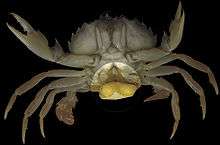Rhizocephala
| Rhizocephala | |
|---|---|
 | |
| Externa (highlighted) of mature female Sacculina on a female Liocarcinus holsatus | |
| Scientific classification | |
| Kingdom: | Animalia |
| Phylum: | Arthropoda |
| Subphylum: | Crustacea |
| Class: | Maxillopoda |
| Subclass: | Thecostraca |
| Infraclass: | Cirripedia |
| Superorder: | Rhizocephala Müller, 1862 |
| Orders | |
| |
Rhizocephala are derived barnacles that parasitise decapod crustaceans. Their body plan is uniquely reduced in an extreme adaptation to their parasitic lifestyle, and makes their relationship to other barnacles unrecognisable in the adult form. The name Rhizocephala derives from the Greek roots ῥίζα (rhiza, "root") and κεφαλή (cephale, "head"), describing the adult female, which mostly consists of a network of thread-like extensions penetrating the body of the host.[1]
Description and lifecycle
As adults they lack appendages, segmentation, and all internal organs except gonads, a few muscles, and the remains of the nervous system. Other than the minute nauplius stages, the only distinguishable portion of a rhizocephalan body is the externa or reproductive portion of adult females.
Nauplii released from adult females swim in water for several days without taking any food (the larva has no mouth and no intestine) and transform into cypris larvae (cyprids) after several moults. In some species, for example, Thompsonia, embryos develop directly into cypris larvae before they are released from adult females. A female cypris settles on a host and metamorphoses and injects its internal cell mass into host animal. The cell mass then grows into root-like threads through the host, centering on the digestive system. This network of threads is called the interna. The female then grows a sac-like externa extruding from the abdomen of the host.[2]
The externa remains immature until a male cypris injects his internal cells into a female's externa, where cypris cells transform into sperm-producing cells within a pair of cypris cell receptacles which were once called the testes. The mature female's externa produces two types of eggs: small eggs, when fertilised, become female cypres and the large eggs become male cypres. A female externa produces several batches of larvae before it drops off the host. The host soon moults and a new young externa, "budded" from the interna, emerges from the host's body. In some species, such as Peltogasterella gracilis, many externae develop from one interna.
The externa is where the host's egg sac would be, and the host's behaviour is chemically altered: it is castrated and does not moult until aged externa(e) drop(s) off. The host treats the externa as if it were its own egg sac.[2] This behaviour even extends to male hosts, which would never have carried eggs, but care for the externa in the same way as females.[2]
Classification
Following the 2001 review by Martin and Davis, the Rhizocephala are ranked as a superorder and divided into two orders which together contain 9 families and two genera which cannot be unequivocally assigned to a family:[3][4]
|
Order Akentrogonida Häfele, 1911
|
Order Kentrogonida Delage, 1884
|
References
- ↑ "Etymology of the Latin word Rhizocephala". MyEtymology. Retrieved June 24, 2011.
- 1 2 3 Henrik Glenner & Jens T. Høeg (2002). "A scenario for the evolution of the Rhizocephala". In Elva Escobar-Briones & Fernando Alvarez. Modern Approaches to the Study of Crustacea. Springer. pp. 301–310. ISBN 978-0-306-47366-1.
- ↑ J. W. Martin & G. E. Davis (2001). An Updated Classification of the Recent Crustacea (PDF). Natural History Museum of Los Angeles County. pp. 132 pp.
- ↑ Daphne Cuvelier (2009). M. Schotte; C. B. Boyko; N. L. Bruce; G. C. B. Poore; S. Taiti; G. D. F. Wilson, eds. "Rhizocephala". World Marine, Freshwater and Terrestrial Isopod Crustaceans Database. World Register of Marine Species. Retrieved June 3, 2011.
External links
 Data related to Rhizocephala at Wikispecies
Data related to Rhizocephala at Wikispecies Media related to Rhizocephala at Wikimedia Commons
Media related to Rhizocephala at Wikimedia Commons